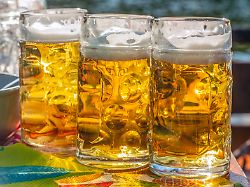Dry spell for German brewers
Beer industry struggles with falling demand
08/01/2023 2:24 p.m
Weather, inflation, corona and health trends: Germans seem to have less and less desire for beer. Bad news for breweries stuck in crisis mode since the pandemic. Only a glimmer of hope remains for them.
First Corona, then horrendous increases in the cost of living: people in Germany have less and less desire for beer. As a result, the breweries and beer warehouses sold less of the alcoholic beverage than before in the first half of the year. 4.2 billion liters meant a decrease of 2.9 percent compared to the same period last year, as reported by the Federal Statistical Office. Only in the Corona year 2021 was less beer sold and drunk in the first half of the year – when restaurants and folk festivals remained largely closed.
Far away is the pre-crisis level, which was only characterized by a gradual decline in consumption because the average age of people in Germany is drinking less beer and wanting to eat healthier. In the first half of 2019, producers sold around 375 million liters more beer than at present. Over 80 percent of production remains domestic, exports have been somewhat more stable in 2023.
Beer industry in the “Long Covid”
The German Brewers’ Association gives reasons for the unexpectedly weak half-year result. In addition to the cool and mixed weather in spring, inflation is keeping consumers from spending. Trade, gastronomy and breweries would feel this, says general manager Holger Eichele. The companies can only pass on a small part of the costs, which have exploded since the beginning of the Corona crisis, as higher prices.
According to the latest studies by the NielsenIQ market researchers, however, the base prices for beer in the supermarket have recently risen. The old promotional price of 9.99 euros for a crate of beer has largely disappeared from retail brochures.
Niklas Other from the industry journal “Inside” still sees the industry in the “Long Covid”. After the Corona crisis, companies could no longer get back on their feet. The trade journal reports that even the big brands could not escape the negative trend, despite the high frequency of their special offers. With the exception of the Warsteiner and Erdinger brands, the ten largest suppliers suffered sales losses.
“The Easter business was a total failure – consumers simply didn’t buy it,” reports Veltins boss Michael Huber. This can no longer be recovered. Ultimately, the new reality of the beer market has arrived. Every brewery is also facing enormous investments in more climate-friendly production facilities. The Veltins manager also sees the discordant traffic light coalition as responsible for the sluggish consumer mood: “When inflation reaches into their wallets, consumers automatically close their wallets. When the state wants to make additional savings, as with the heating law, households look for basic orientation , because worries about the future are taking hold.”
Non-alcoholic beers are becoming increasingly popular
There is still a glimmer of hope for Eichele, member of the Brewers’ Association, and many companies: Non-alcoholic types of beer have been benefiting from the health trend for years, and the Federal Office reported on this outside of the tax statistics. Of these, 474 million liters worth 396 million euros were produced over the past year, a share of more than seven percent of the total emissions. This means that the volume of non-alcoholic beer has almost doubled within ten years. During this period, light mixed beer drinks such as Radler grew by 24 percent to 403 million liters last year.
In the catering trade, non-alcoholic varieties have already captured 14 percent of all beer orders, reports the gastro digital service provider Kollex in its market monitor for Beer Day (4 August). In addition, there is a relatively constant 5 percent of mixed beer drinks.
